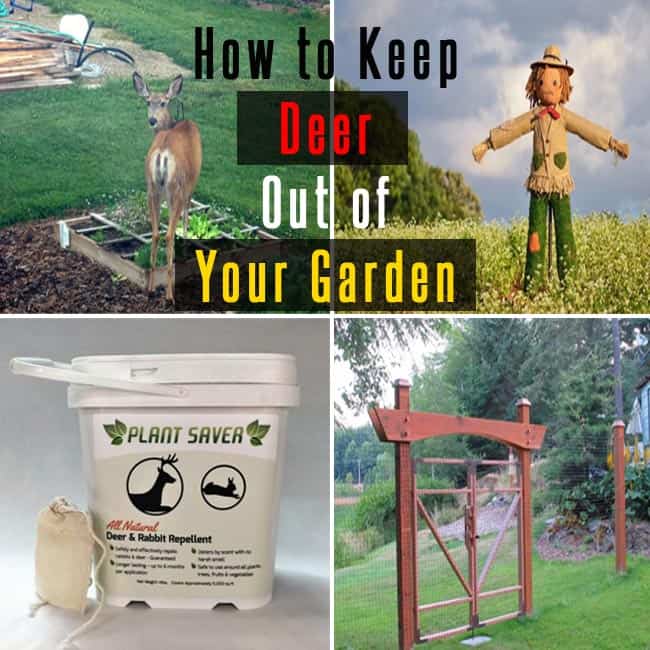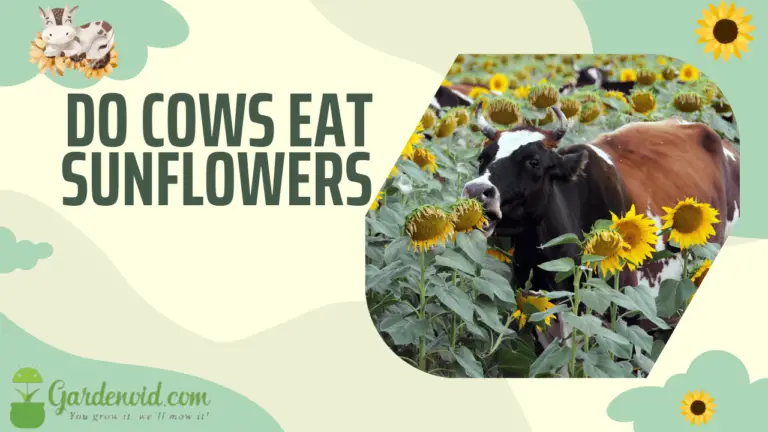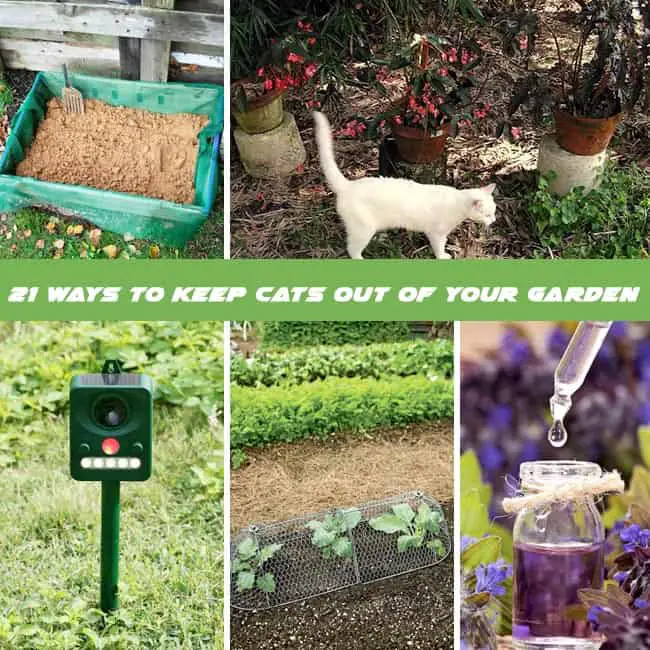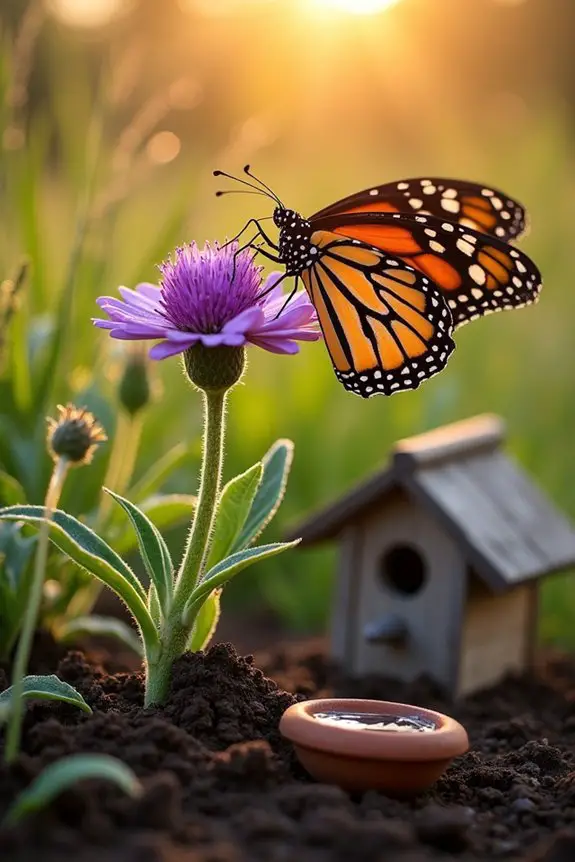How to Make DIY Pinecone Bird Feeders At Home
Creating pinecone bird feeders changes ordinary backyard spaces into bustling wildlife havens where colorful songbirds gather each morning.
These simple, natural creations require just a few common materials—fresh pinecones, creamy peanut butter, and mixed birdseed….. yet deliver extraordinary results that bring families closer to nature’s daily rhythms.
The gentle process of preparing these rustic feeders offers peaceful moments while promising months of delightful bird-watching experiences that will enchant both children and adults with nature’s vibrant displays.
Quick Summary
- Choose large, fully opened pinecones (3-5 inches) with sturdy, well-spaced scales from pine, spruce, or fir trees.
- Clean pinecones thoroughly and dry them in sunlight for 24 hours to ensure proper seed adherence.
- Spread creamy peanut butter evenly into crevices using a butter knife, wooden spoon, or fingers.
- Roll peanut butter-coated pinecones in mixed birdseed, then attach string or twine for hanging.
- Hang feeders 6+ feet high on sturdy branches near bushes, spacing multiple feeders 10 feet apart.
Materials and Tools You’ll Need
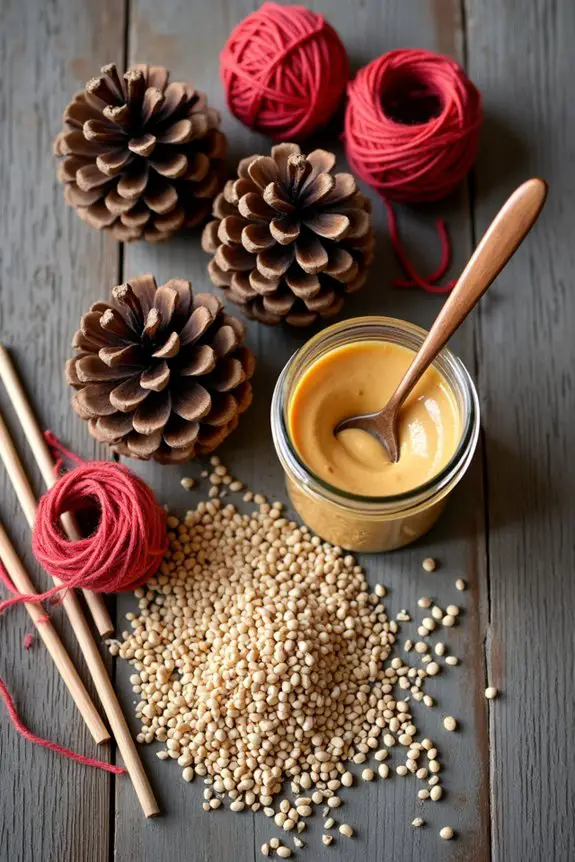
Gathering the materials a simple afternoon project into a delightful journey of creativity and nature connection.
Essential supplies include large, open pinecone types like pine, spruce, or fir cones with wide-spread scales. Creamy peanut butter serves as the sticky foundation, while mixed birdseed creates colorful texture and nutritional value.
String or twine enables easy hanging from sturdy branches. A butter knife spreads ingredients smoothly across pinecone surfaces. Shallow plates hold seeds for rolling and coating.
These humble materials combine into enchanting feeding stations, creating peaceful moments for feeding birds while fostering meaningful connections with backyard wildlife.
Choosing the Right Pinecones

While wandering through wooded areas or neighborhood parks, crafters should seek fully opened pinecones with broad, sturdy scales that create perfect perches for hungry birds.
Different pinecone types offer unique advantages for this delightful project. Long, elegant pine cones work beautifully, while shorter, rounder varieties from spruce trees provide charming alternatives.
Size selection proves crucial for success, as medium to large cones measuring three to five inches long hold generous amounts of seed-laden peanut butter.
Avoid closed or damaged cones, and choose specimens with well-spaced scales that allow easy spreading and create inviting landing spots for feathered visitors.
Preparing Your Pinecones

Once collected, these treasured woodland gems require gentle cleaning to transform them into welcoming dining stations for backyard visitors.
Cleaning pinecones begins with removing debris, leaves, and tiny insects hiding between their scaled layers. A soft brush works perfectly for this delicate task, sweeping away nature’s remnants while preserving the cone’s natural beauty.
After thorough cleaning, drying pinecones becomes essential for proper seed adherence. Place them on newspaper in a warm, sunny spot for twenty-four hours, allowing moisture to evaporate completely.
This careful preparation creates the perfect foundation for crafting irresistible treats that feathered friends will absolutely adore.
Applying Peanut Butter to Pinecones

With clean, dry pinecones ready for transformation, the enchanting process of coating them with creamy peanut butter begins. Using a butter knife or wooden spoon, gently spread the golden mixture into every crevice and groove. The rich, nutty aroma fills the air as each scale receives its delicious coating.
| Spreading Techniques | Best Results |
|---|---|
| Butter knife method | Even coverage |
| Wooden spoon approach | Deep penetration |
| Finger application | Natural control |
| Pastry brush technique | Light coating |
| Rolling motion | Complete saturation |
Consider peanut butter alternatives like sunflower seed butter for allergic-friendly options that birds adore equally.
Rolling in Birdseed
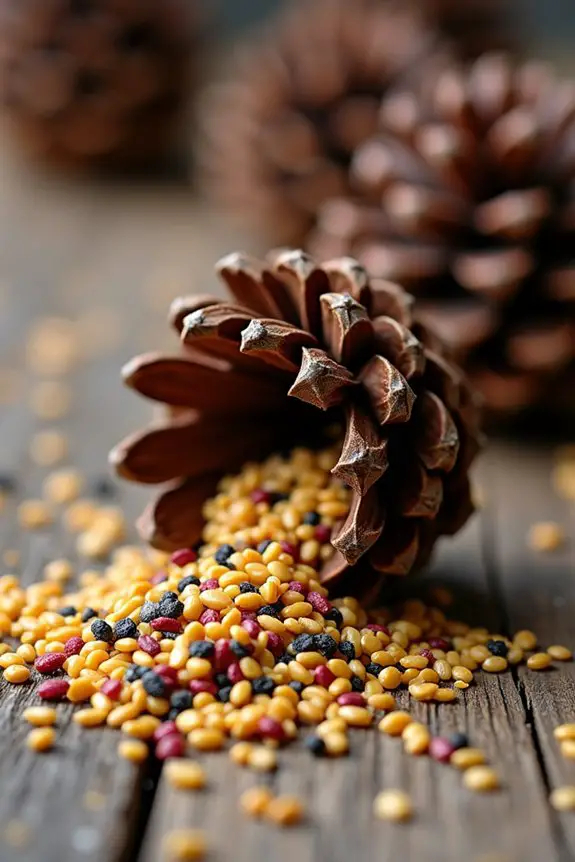
The peanut butter-coated pinecones now await their final enchanting transformation as they prepare to meet a rainbow of colorful birdseed.
Pour generous amounts of mixed birdseed varieties into a shallow dish, creating a vibrant carpet of nutritious seeds.
Gently roll each sticky pinecone through the seeds, pressing lightly to ensure complete coverage. The sunflower seeds, millet, and nyjer seeds cling beautifully to every crevice and surface.
This winter feeding masterpiece transforms ordinary pinecones into irresistible bird magnets that will attract cardinals, chickadees, and finches throughout the coldest months, bringing life and joy to any backyard sanctuary.
Hanging Your Feeders

Strategic placement transforms these seed-covered treasures into perfect outdoor dining establishments for feathered visitors.
Proper hanging techniques ensure maximum bird attraction while creating enchanting garden focal points that bring nature’s symphony directly to your window.
- Choose sturdy tree branches at least six feet high, providing natural perches and protection from ground predators.
- Position feeders near shrubs or bushes where birds can quickly escape to safety while maintaining clear flight paths.
- Space multiple feeders ten feet apart to prevent territorial disputes and accommodate various bird species simultaneously.
Smart feeder placement creates wondrous outdoor theaters where colorful cardinals, cheerful chickadees, and graceful nuthatches gather daily.
Maintenance and Refilling Tips
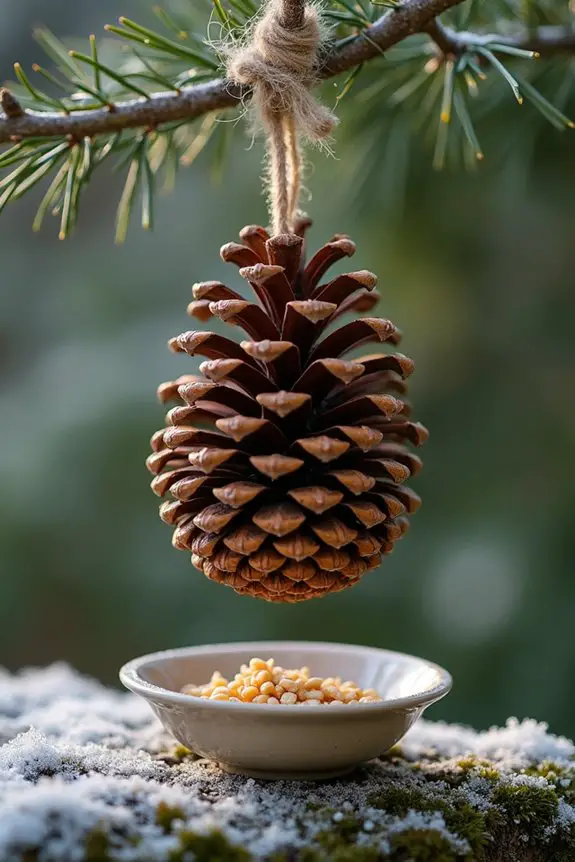
Once your pinecone bird feeders begin attracting their delightful winged guests, simple upkeep practices will keep these charming feeding stations flourishing throughout the seasons.
Establishing a weekly refilling schedule ensures hungry birds always find fresh, nutritious seeds coating each rustic pinecone surface. Gently brush away old seeds before spreading creamy peanut butter and rolling in premium birdseed mixtures.
Consider rotating your feeder location periodically to prevent ground accumulation beneath your favourite perches. During harsh winter months, increase refilling frequency as energetic birds consume more calories.
These thoughtful maintenance routines transform ordinary backyard spaces into thriving wildlife sanctuaries that sparkle with endless avian activity.
Popular Questions
What Types of Birds Will Be Attracted to Pinecone Feeders?
Pinecone feeders attract various songbird species including chickadees, nuthatches, woodpeckers, and finches. These birds have natural feeder preferences for seeds and nuts, making pinecone feeders an ideal backyard attraction for observing diverse avian visitors.
When Is the Best Time of Year to Put Out Pinecone Feeders?
Fall through early spring offers the best seasonal timing for pinecone feeders when natural food sources become scarce. Ideal weather conditions include dry periods after storms, as birds actively seek high-energy foods during colder months.
How Long Do Pinecone Bird Feeders Typically Last Outdoors?
Pinecone bird feeders typically last one to three weeks outdoors, depending on weather conditions and bird activity. Regular feeder maintenance, such as checking for mold or replacing depleted seed coating, extends their effectiveness significantly.
Are Pinecone Feeders Safe for Squirrels and Other Wildlife to Eat?
Yes, pinecone feeders are generally safe for squirrels and other wildlife. The natural materials provide wildlife benefits, though squirrel safety requires using appropriate seeds and avoiding chocolate or salted ingredients that could harm them.
Can I Use Alternatives to Peanut Butter for Nut Allergies?
Yes, sunflower seed butter serves as an excellent peanut butter substitute for pinecone bird feeders. Coconut oil also works well when mixed with seeds. Both alternatives provide safe, nutritious options for those with nut allergies while attracting birds effectively.

